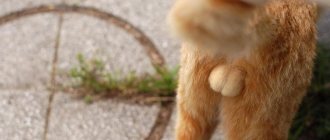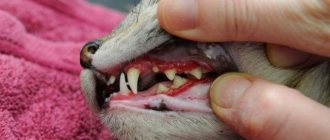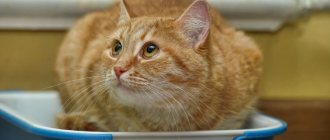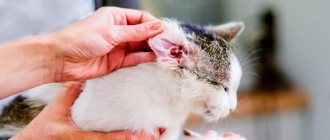Should cat owners be concerned if they find blood or mucus in their cat's stool? In this article, we describe in sufficient detail the probable causes of these phenomena and answer the main question: “is it dangerous?”
We all do it. We do this every time we change the tray or hear claws scraping the litter. I'm talking about examining our cat's poop. We humans have an inexplicable interest in monitoring the waste products of our companion. And this is good. Identifying a litter box problem early can prevent more serious complications and restore the health of a sick kitten. According to statistics, intestinal upset/diarrhea is the sixth most common disease in cats. One of the most common intestinal problems reported by cat owners is blood or mucus in the stool. Should you be concerned if you notice drops of blood or clots of mucus in your cat's litter box? Let's find out.
What does normal cat stool look like?
Typical cat poop is about 5-6 cm long, 1 cm in diameter, well formed and predominantly brown in color. If your cat has abnormal bowel movements, you can give your assessment of the feces. Assessing the quality of feces and estimating the quantity can help your veterinarian diagnose your cat's condition more quickly and correctly.
Most cats defecate once a day. The smell should not be too strong. When changing the tray, you may notice that normally the stool should not be liquid.
When to take your pet to the doctor
You should contact your veterinarian in the following cases::
These manifestations are often accompanied by additional symptoms:
- decreased appetite;
- diarrhea with vomiting;
- increased frequency of urination;
- lethargy, apathetic mood of the pet;
- pronounced thirst;
- sudden weight loss;
- the cat runs its butt on the carpets (a sign of problems with the anal sinuses).
With these signs, you also need to observe how many times a day the cat walks around, how often there is blood and how much of it, whether there are other foreign impurities (mucus, remains of fur or undigested food, etc.). You also need to pay attention to the cat’s behavior and mood, how he eats, how much he drinks, whether there is vomiting and fever. You will need to tell the veterinarian about all this when your pet comes in for an appointment. This will help speed up diagnosis and initiation of treatment.
© shutterstock
What does blood look like in my cat's stool?
Blood in a cat's stool can be difficult to detect. For starters, cat litter can sometimes change color and hide or create changes in the appearance of the stool. If the blood originates in the lower intestine, especially the distal colon or rectal area, it will most likely appear as blood. Red or pink drops or smears are often found on the sides of the cat's litter box and on the top of the stool or litter.
Blood from the upper intestinal tract, especially the small intestine, will be black or brown. This color change is due to partial digestion by enzymes secreted in the small intestine. This blood often appears as dark spots, streaks, or looks like coffee grounds.
It's important to note that both constipation and diarrhea can cause blood in a cat's stool. Bright red blood without diarrhea or hard, dry stool usually indicates the problem is closer to the rectum and anus.
Stool with a blood clot in a cat or dog
Some time ago, an old friend of mine told me how scared she was when she noticed a blood clot in her dog’s stool. It was the holidays, and she took pity on me and didn’t want to bother me. As a result, she got an adventure that cost her quite a round sum and several days of hassle.
I think many have encountered a similar situation. And I consider it necessary to tell you about what is behind such a striking and spectacular symptom as blood in the stool.
So, let's start in order...
What causes blood in stool?
The blood clot itself is not as dangerous as it seems at first glance. Its task is to draw attention to the problem and give a signal about the state of the diseased organism. That is, one should not be afraid of blood, but solve the problem that this blood communicates.
The condition of the clot tells the doctor a lot: about the severity and strength of the inflammatory process, about the condition of the intestines, about the functioning of the blood coagulation system and much more...
Bleeding occurs due to the inflammatory process in the large intestine. The causes of this inflammation can be a variety of irritants. Violation of the acidity of feces, viruses, helminths, various protozoa, neoplasms, rough mechanical particles (for example, bone fragments), allergic reactions - there are quite a few reasons for this condition.
A blood clot in the feces of a dog or cat is a signal of problems, which can be identified by a comprehensive examination of your pet and close contact between the owner and the attending physician.
The appearance of a blood clot is a sign that should prompt the owner not only to refuse first aid, relieving the external symptoms of the inflammatory process with antibiotics, but also to treat the underlying cause of the disease.
How to find the reason?
From what is written above, you, dear reader, have probably already understood that simply treating such phenomena “at random” is not only not useful, but even dangerous. By smoothing out the signs of the inflammatory process and “extinguishing” the secondary infection, you can allow the main cause of the disease to continue to destroy your pet’s intestinal wall.
This means that it is necessary to accurately determine the cause that causes the primary destruction of the intestinal wall. This can be done if you analyze all the circumstances associated with changes in your pet’s health. It is better to do this together with a specialist who knows what questions to ask you in order to collect an accurate history (information about the occurrence and course of the disease) and what diagnostics to prescribe in order to identify the main cause.
To diagnose such a problem, as a rule, a complex method is used, which includes both general clinical examination methods and special diagnostic methods.
Depending on the collected medical history and the results of general clinical tests (blood and stool tests), the doctor will draw up a special diagnostic plan, which may include ultrasound and x-ray examinations, virological and parasitological immune tests, stool microscopy, endoscopic examination, cytology and/or histology of the intestinal wall , and sometimes a trial treatment.
The doctor draws up a diagnostic plan for the patient based on the collected medical history. Diagnosis of inflammatory reactions of the intestinal wall can be multi-stage due to the variety of possible causes with very similar symptoms.
Depending on the complexity of the problem, diagnosis may take longer.
For example, protozoa cannot always be detected in feces due to the fact that their development cycles involve uneven release of these microorganisms into the intestinal lumen. Sometimes they are simply not present in the feces. In addition, a whole association of microorganisms often coexists in the intestines of cats and dogs, which can influence the numbers of other members of the association. Therefore, having destroyed one of the members of this association, we often get a massive proliferation of the remaining representatives of the association of microorganisms.
And if, for example, the disease provokes a violation of bile secretion, then it does not always have time to recover quickly, and the digestive disturbance continues, despite the destruction of harmful microorganisms. Therefore, additional treatment and nutritional therapy may be required.
It also happens that under certain living conditions it is simply impossible to completely get rid of a parasite. These could be, for example, lamblia (giardia). Having rid your pet of them today, you can again see manifestations of giardiasis in a week, because the pet drinks water contaminated with these protozoa or gets them from licking contaminated toys and other objects.
I hope you now understand why laboratory diagnosis of such diseases and further treatment are not always successful the first time. Or they are insufficient. This situation cannot please the owners, and sometimes leads to distrust of the doctor. But you already know that the reason may not be the doctor.
Therefore, even if the doctor’s first actions do not bring the desired result, just ask the doctor about further plans. If the doctor has a certain strategy, then you have a lot of chances to achieve success in diagnosis and treatment. And changing a doctor, at best, will lead to a rollback of diagnosis and treatment to the beginning.
Trust in a doctor is a very important part of a multi-stage diagnosis.
But sometimes, changing your doctor can help you. This must be done when the doctor does not have a clear treatment strategy, when he is “lost” and does not know “where to think next.”
How to help your pet?
All assistance will be divided into first aid and, in fact, treatment of the underlying disease. First aid relieves the severity of the reaction to the inflammatory process, helps fight secondary infection and allows you to normalize the process of defecation. In some cases, it is necessary to further enhance blood clotting to avoid excess blood loss through the damaged intestinal wall.
As a rule, in most cases, antimicrobial drugs (in most cases, semi-synthetic penicillins with clavulanic acid), antispasmodics and agents that envelop the intestinal wall are used for first aid. In cases of severe bleeding, hemostatic agents (etamsylate, aminocaproic acid, tranexam) are used.
First aid is only the first step in finding and fixing the problem.
The use of first aid helps to cope with a one-time symptom of intestinal bleeding, but in any case, you still need to identify the underlying cause of the disease and treat your pet. This is especially true for acute conditions in which an unresolved cause (for example, bone fragments in the intestines) can cost the pet’s life.
How to deal with the problem radically?
To cure your cat or dog, you need to accurately determine the root cause of the problem. We have already described the diagnostic features above. And the selection of treatment depends on the diagnosis.
If the cause is bone fragments in the feces or other mechanical particles, then Vaseline oil or even a surgeon’s scalpel will come to the rescue. If the problem is caused by helminths (worms), then a course of anthelmintics and supportive therapy will help you. If the reason is a broken diet, then you cannot do without normalizing the diet, and if protozoa or microbes, then it’s a matter of selecting an effective remedy for this particular pest.
After completing a course of treatment, it is necessary to monitor its results using the same methods that were used to make the diagnosis. If, despite the disappearance of clinical symptoms, the problem has not been completely eliminated, then, on the advice of a doctor, you should either repeat the course of treatment, or change the drug and take a new course. And so on until complete recovery.
If the cause of the disease cannot be completely eliminated (viral nature, allergic reactions, etc.), then, thanks to correctly prescribed complex treatment, you can achieve stable remission and learn how to quickly and effectively provide first aid to your four-legged friend.
What happened to my friend?
While going out for a walk, she met a neighbor who told her that blood in her dog’s stool was almost fatal. Frightened Olga (that was her name) began urgently calling emergency veterinary emergency numbers. The doctor arrived, gave several injections, and took tests. He promised to prescribe a course of treatment based on the results.
By the way, the wealthy Olga, having heard the cost of the services provided, shuddered slightly. My services in such a situation would cost her about 2 times less. But she didn’t specify the cost of the doctor’s services before calling... So she had to pay.
Based on the test results, the doctor called and made recommendations. At the same time, remembering the doctor’s words, Olga realized that the doctor’s words differed significantly from what he did and what he tested for... But, as a caring housewife, she decided to follow all the doctor’s instructions, who gave her dog a rather serious diagnosis, although the results it was confirmed and was not analyzed. As a result, a few days later Olga finally called me because the problem had returned. During the examination, we found out that the first aid corresponded to the described symptoms, especially since the dog felt better. But what concerned further treatment had to be significantly adjusted, especially considering the unbalanced diet of Olga’s favorite and the repetition of the unpleasant symptom.
Olga completed the course of treatment, the dog was given proper nutrition, and now Olga and her pet are doing well.
Be careful yourself, choose your doctor wisely, trust your doctor, follow his instructions and believe in the success of your treatment. And everything will definitely work out!
Natalya Troshina, veterinarian (DVM)
What about mucus in the stool?
Slippery. Slimy. Nasty. These are all words veterinarians hear from cat owners describing excessive mucus in their cats' stool. Mucus is a normal secretion of the intestinal tract to help lubricate and moisten the intestines and facilitate fecal passage. It is not uncommon to observe some greasy or slippery coatings on your cat's feces. It is abnormal to see a lot of mucous, often clear to pale yellow-green fluid, accompanying your cat's bowel movements. Fecal mucus is an example of “the more the merrier.”
Treatment depending on the cause
Treatment of intestinal pathologies is prescribed by a veterinarian. The owner must strictly follow his recommendations. The treatment regimen depends on what exactly caused the bleeding.
Poisoning
Poisoning is treated in 4 stages:
- Gastric lavage to remove poison that has not yet been absorbed. Vomiting is contraindicated as it may worsen the animal's condition.
- Administration of electrolytes and forced diuresis. The cat is given intravenous solutions of electrolytes and diuretics to remove the poison from the blood. Required for severe and moderate poisoning.
- Antidote. Neutralizes harmful substances and their metabolites. It is administered if it is known what the cat was poisoned with. For food poisoning, an antidote is not required.
- Symptomatic help.
After the course of treatment, it is important for the cat to take especially careful care in order to completely eliminate all the consequences of poisoning. It is necessary to exclude walks on the street and uncontrolled selection of food.
Parasitic and infectious diseases
For their treatment, drugs of 3 groups are used:
- Etiotropic – affect the causative agents of the disease (antibiotics, anthelmintic drugs).
- Pathogenetic – stop pathological processes (anti-inflammatory drugs, hemostatic agents, electrolytes).
- Symptomatic – against pain, fever and other symptoms.
What causes blood or mucus in my cat's stool?
There can be many reasons for blood or mucus in your cat's stool. Some common reasons include:
- Dietary changes and food intolerances;
- Inflammatory bowel diseases (IBD);
- Intestinal parasites such as Giardia;
- Infections;
- Trauma or abscess;
- Rectal polyps or tumors;
- anal gland abscess or infection;
- Constipation or idiopathic feline megacolon;
- Poisons or toxins;
- Cancer.
Causes of blood in stool
The animal owner’s task is to notice characteristic changes in the state of his pet’s body. The appearance of blood or mucus in a cat’s feces is a reason to contact a veterinary hospital for an accurate diagnosis, since independent determination of the provoking factors is impossible.
There are many reasons for the development of a pathological symptom, but the most common are:
- Infection with helminth infections - parasitic organisms, penetrating into the animal’s body, begin to damage the mucous membrane of the intestinal tract. As a result of the influence of helminths on the intestinal walls, drops of blood appear in the cat’s stool, and other characteristic symptoms also occur - diarrhea, mucus in the feces, pain in the abdominal area.
- Foreign objects in the intestines . If parts of the intestine are damaged or partially blocked by plastic objects or sharp parts of tubular bones, there is a high probability of intestinal trauma. When damaged, symptoms such as refusal to eat, feces mixed with blood, depression, and increased apathy occur.
- Chronic constipation . Heavily compressed and hard feces when passing through the anus can injure the mucous membrane, causing a pathological condition.
- Intoxication of the body with strong poisons. Poisoning an animal with zoocoumarins (poisons intended for baiting rodents) leads to disruption of clotting factors, causing bleeding throughout the body. In addition to blood and mucus in the feces, when poisoned by poisons, an animal may experience bleeding from various places - the nose, mouth, eyes.
- Neoplasms . Tumors of a malignant or benign nature formed in the intestines can provoke extravasation, manifested by blood impurities in the feces.
- Inflammation of the glands in the anal area . Derivatives of the sweat and sebaceous glands located at the transition of the rectum to the anus, secreting a specific secretion - liquid for marking territorial boundaries. Inflammation in the anal glands makes it difficult for the feces to pass out, causing pain and discomfort to the animal. When the integrity of the mucous membrane is violated, blood appears in the stool during the act of defecation.
- Parvovirus and coronavirus enteritis. Infectious diseases affecting the intestinal tract most often affect young cats and kittens. The danger of enterovirus infections lies in the rapid development of pathology, accompanied by diarrhea in the cat, extravasation in the feces due to a violation of the integrity of the intestinal mucosa and some other characteristic signs.
- Problems with clotting factors. A disease such as hemophilia also occurs in representatives of the cat family. The disease manifests itself not only by the appearance of blood in the stool, but also by other characteristic symptoms - extravasation from the nasal and oral cavities, prolonged wound healing, and weak immunity.
- Diseases of internal organs . The reasons for the appearance of bloody stools or feces with streaks of heme may be associated with disruption of the functioning of internal organs - the liver, pancreas, small or large intestine, as well as with stomach ulcers.
- Bacterial infections. The penetration and development of pathogenic microflora in the intestines of an animal can provoke serious disruptions in the functioning of the organ. Bacteria such as salmonella, campylobacteria, E. coli or colibacteria lead to dehydration and diarrhea with blood. Not timely treatment of a bacterial infection leads to the death of the animal.
- Cracks or wounds in the anal area . Damage to the anal sphincter not only leads to problems with defecation and the appearance of blood particles in the feces, but also causes discomfort to the pet. The cat may simply be afraid to go to the toilet for a long time due to painful sensations.
Particularly worth noting is diarrhea with blood in a pregnant cat, because this condition threatens the life of the pet. The cause of streaks of blood in loose, watery stools are inflammatory processes in parts of the large intestine, tumor processes, or infectious diseases.
If a severe symptom occurs that lasts more than two days, you should take your pet to a veterinarian for further thorough examination.
What will the veterinarian do to determine the cause?
Most of these problems can be diagnosed based on the animal's medical history, physical examination, and microscopic examination of the animal's stool. Your veterinarian will look for blood, parasites, bacteria, and other possible causes of blood and/or mucus. In more serious cases, X-rays, ultrasound, blood and urine tests will be performed. Treatment will be based on an accurate diagnosis.
If you notice anything strange in your cat's feces, don't hesitate; Contact us for veterinary help. We've seen too many cats for whom it was too late to get help, simply because their owners hoped to solve the poop problem on their own. And our best advice is to continue to monitor your cat litter carefully.
If you are unsure, consult with our veterinarian—they will be your best resource in determining which toys and objects are safe for your cat, and can also give you tips on how to prevent your cat from eating strange objects.
Diagnostics
To diagnose the disease, you can collect a sample of cat feces without filler in a sterile container and take it with you to your appointment at the veterinary clinic. Feces are tested for coronavirus enteritis and protozoa.
Blood tests are also taken from the cat
to exclude anemia, blood clotting disorders, assess the general condition of the animal and the functioning of internal organs.
Using ultrasound
and
x-ray,
the presence of formations in the cat’s intestines and foreign bodies is diagnosed.
Colonoscopy
– examination of the intestines using a special apparatus (carried out under anesthesia).
Using this study, you can detect small polyps and intestinal tumors that cannot be diagnosed by ultrasound, and also take a biopsy
(a piece of intestinal tissue) for analysis.
Scarlet and pink discharge
By emptying the stomach, the animal is freed from fluff, an accidentally swallowed thread, or a bead, but not every owner knows what to do when a cat vomits blood. Fresh scarlet inclusions are released when the oral mucosa is injured by bone, pieces of unchewed food, or when a tooth falls out. With prolonged fasting, reddish traces are noticeable in the bile expelled by the stomach; the cat vomits with blood of a scarlet hue:
- with a tumor in the esophagus;
- in case of organ damage;
- when the shell is corroded, which occurs after the use of drugs.
In case of intoxication, which occurs from poisoning with spoiled food, the cat vomits for a long time, and this leads to the rupture of capillaries, which color the saliva and vomit scarlet.
The pink foam that comes out of your pet’s mouth is formed when there is a strong cough that occurs during a cold or when the respiratory tract is infected.
Diagnostic features
To find out why a cat has blood in its stool, a veterinarian performs a diagnosis. The procedure involves the use of different techniques, but first of all, blood is taken for a detailed analysis. It is also necessary to submit your pet’s stool to be examined for protozoan microorganisms and helminths, as well as to detect internal bleeding.
A laboratory method called coprogram is highly informative at the stage of diagnosing diseases in cats. With its help, you can find out what microscopic composition the blood in cat feces has, as well as identify hidden bleeding. Additional tests performed when blood is detected in a cat's stool :
- Analysis of urine;
- Ultrasound of the abdominal organs;
- X-ray of the abdominal organs;
- colonoscopy examination.
© shutterstock
A set of diagnostic procedures allows the veterinarian to make the correct diagnosis and create an effective treatment regimen.
Diagnosis and treatment
Blood in the stool can indicate a wide range of diseases. That’s why you shouldn’t self-medicate or ignore the problem altogether. Only a doctor can make an accurate diagnosis after conducting a series of studies.
First, the veterinarian will interview the owner. It is necessary to talk about whether the cat has any other symptoms of the disease, describe the pet’s diet, does the cat have access to household chemicals or other items that it could swallow, has it previously had diarrhea or constipation, has it cleaned The cat's stomach has been affected by fur lately.
First of all, the doctor will take stool for analysis. Using a microscope, he will be able to eliminate the possibility of parasitic infestation. A general blood test can indicate the presence of any inflammatory processes in the animal’s body, or anemia. In addition, blood should be examined for clotting.
A general urine test will help determine whether there are inflammatory processes in the kidneys. With the help of palpation, you can determine the presence of anal fissures and tumors, and assess the condition of the paraanal glands.
An ultrasound of the abdominal area will help to see the inflammatory processes occurring in the internal organs. X-rays (including the use of contrast) will help detect foreign objects in the intestines.
In some cases, endoscopy is necessary to make an accurate diagnosis. The same method can eliminate minor bleeding in the intestines and take tissue for analysis. The procedure is performed under anesthesia.
Treatment directly depends on the diagnosis.
- If the cause is parasitic infestation, the cat is given anthelmintics. Moreover, the medicine must be given several times with an interval of 10 days until all the helminths leave the body along with the feces.
- For infectious diseases, a course of antibiotics is prescribed. You may also have to give your animal anti-inflammatory and painkillers.
- When there is an intestinal blockage, the animal is first given castor oil or given an enema. If the stuck object is too large, surgical intervention is prescribed. Surgery is also prescribed in case of tumors appearing on the intestinal walls. Surgery is especially important if the tumors are growing.
- When the anal glands become inflamed, the doctor cleans the clogged pores and removes all the accumulated pus.
- If anal fissures occur, special suppositories with sea buckthorn oil are prescribed. The owner can administer the suppositories himself 2 times a day. In this case, the animal must be held in your arms for about ten minutes until the candle melts.
- In case of poisoning, the cat's stomach is cleansed and medications are given that remove toxins from the animal's body. If there is excessive vomiting and dehydration, the animal is given a drip.
- If you experience frequent constipation, your doctor will prescribe a special diet. You can add food to your diet that is intended for animals with gastrointestinal disorders. In some cases, dry food is completely removed from the diet, replacing it with canned food or natural food.
We recommend the article: How to rid a cat of growths on his pads?
Diagnostic testing for vomiting in a cat
Due to the severity of the symptom and the long list of possible causes, your cat may be offered standard tests and additional investigations.
Call a veterinarian Moscow
+7(495)162-70-70
- Complete blood count, urinalysis and biochemical profile.
To assess your cat's overall health, look for signs of infection, inflammation, liver function, and platelet count.
- Endoscopy.
To identify tumors, ulcers and foreign objects in the digestive tract.
- Biopsy of the intestinal tract.
To identify inflammatory cells in the intestinal wall.
- A test to measure blood clotting time.
- Stool examination.
Under a microscope to check for the presence of worm eggs.
- Ultrasound or X-ray.
To assess the presence of foreign objects, neoplasms and examine internal organs.
Professional intervention
On the other hand, if there are repeated sightings of blood accompanied by diarrhea or vomiting, your kitten may be facing a serious health problem that requires immediate veterinary attention. Bring a stool sample to your local veterinary clinic and your veterinarian can perform a series of tests, including an ultrasound, urine test, and abdominal x-ray to find out the real problem.
Based on an accurate diagnosis, it is expected that prescribing antibiotics will help eliminate bacterial infections. If your cat has parasites, deworming may be recommended. Additionally, natural supplements such as slippery elm extract may help your cat, but be sure to consult with your veterinarian before trying it. This is because some cats may develop allergic reactions to natural ingredients. At the same time, you should strictly follow your veterinarian's recommendations for a special diet for your cat in order to achieve the most desirable results in the recovery process.
Finally, closely monitor every change in his behavior day by day to see whether his health is improving or not. Contact your veterinarian immediately if the situation worsens and take immediate action.










